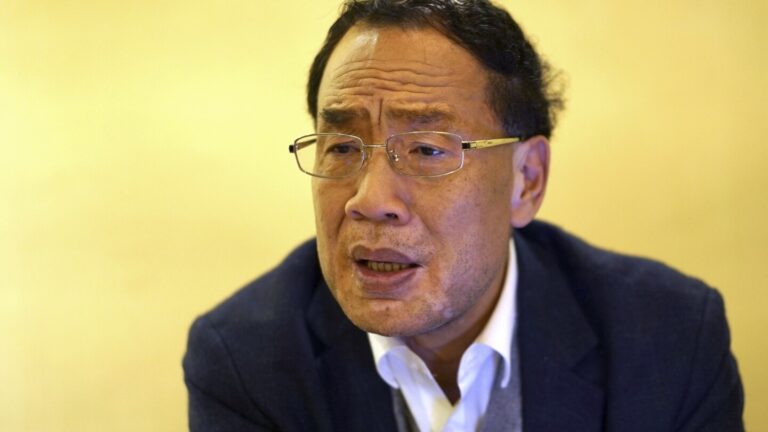SHANGHAI (AP) — The scientist who was the first in China to publish a set of sequences for the new coronavirus staged a sit-in protest outside his lab after authorities locked him out of the facility — an attack that the Chinese government This is a sign that the expansion continues. pressure on scientists We are conducting research on coronavirus.
Zhang Yongzhen wrote in an online post on Monday that he and his team were suddenly notified that they would be ordered to leave the lab. This is the latest in a series of setbacks, demotions and expulsions since the virologist published a sequence without state approval in January 2020.
When Zhang tried to go to the lab over the weekend, security guards barred him from entering. During the protest, he was seen sitting outside on a flat piece of cardboard in the drizzling rain, photos from the scene posted online showed. News of the protests spread widely on Chinese social media, and Zhang told his colleagues he had been sleeping outside the lab, but it was not clear Tuesday whether he remained in the lab.
“I will not leave, I will not quit, I will pursue science and truth!” he wrote in a post on Chinese social media platform Weibo that was later deleted.
Associated Press correspondent Charles de Ledesma reports that prominent Chinese scientists are protesting their eviction from their labs.
The Shanghai Public Health Clinical Center said in an online statement that Zhang’s laboratory was undergoing renovations and was closed for “safety reasons.” It added that it provided Zhang’s team with an alternative experimental space.
However, Zhang said online that his team was not presented with an alternative until they were notified of the eviction, that the proposed lab did not meet safety standards to conduct research, and that the team was left at a loss. wrote.
Zhang’s recent difficulties reflect how China has tried to manage virus-related information: Associated Press investigation finds the government froze Significant national and international efforts to track outbreaks from the first weeks. This pattern continues to this day, with labs closed, research collaborations scuttled, foreign scientists expelled, and Chinese researchers banned from leaving the country.
Reached by phone on Tuesday, Zhang said it was “inconvenient” to speak because others were listening. In an email to co-researcher Edward Holmes on Monday seen by The Associated Press, Zhang admitted that he had been sleeping outside the lab after security had cordoned off entry and prevented him from entering. Prevent.
An Associated Press reporter was stopped by security guards at the entrance to the compound that houses Zhang’s lab. An official at China’s top health authority, the National Health Commission, said by phone that the commission was not the primary department and referred questions to the Shanghai government. The Shanghai government did not respond to requests for comment.
Zhang’s ordeal began on January 5, 2020, when he and his team decoded the virus and wrote an internal notice warning Chinese authorities of the potential spread, but the sequence was never made public. There wasn’t. The next day, Zhang’s lab was ordered temporarily shut down by top Chinese health officials, and Zhang came under pressure from Chinese authorities.
At that time, in China Dozens of people have been reported They were being treated for respiratory illnesses in central Wuhan. Possible cases of the same illness were also reported in Hong Kong, South Korea and Taiwan in recent travelers who had visited the city.
Foreign scientists soon learned that Zhang and other Chinese scientists had decoded the virus and called on China to release the sequence. Zhang published this paper on January 11, 2020. no government permission.
Sequencing the virus is key to developing test kits, disease control, and vaccinations. The virus eventually spread to every corner of the world, sparking a pandemic that disrupted life and commerce, prompted widespread lockdowns, and killed millions of people.
Zhang was later awarded an award for his accomplishments.
But Zhang’s collaborator Holmes, a virologist at the University of Sydney, said the release of Zhang’s sequence also prompted further scrutiny of his lab. Zhang was removed from his post at the Chinese Center for Disease Control and Prevention and banned from collaborating with some of his former partners, hampering his research.
“There has been a campaign against him ever since he defied authorities by publishing the genome sequence of the virus that causes COVID-19,” Holmes said. “He had his heart broken during this process, but I was amazed that he was still able to work.”

